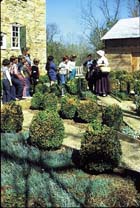Tar Heel Travels
Charlotte's
'Best-Kept Secret
The Museum of History, with new
leadership
and a new building, aims for a higher profile
By Bill F. Hensley
 Trustees of the Charlotte Museum of History knew they had
a winner when they opened a new $7 million facility in
1999 that replaced a small interpretive center for the
Hezekiah Alexander House that had been in operation since
1976. But after a year, the message just hadn't gotten
around, so they went looking for a top-notch president
with a solid background in public relations and
promotions. Trustees of the Charlotte Museum of History knew they had
a winner when they opened a new $7 million facility in
1999 that replaced a small interpretive center for the
Hezekiah Alexander House that had been in operation since
1976. But after a year, the message just hadn't gotten
around, so they went looking for a top-notch president
with a solid background in public relations and
promotions.
They found him in New York
but he was a native North Carolinian. “I found out
in a hurry how little-known this magnificent museum
was,” says William P. Massey, the new chief
executive officer. “At a party, I was introduced to
a prominent city leader who freely admitted he didn't
know who we were, where we were located, or what we had
to offer. It was apparent that we were the city's
best-kept secret.”
Look for that to change,
however, as Massey, who joined the staff in August, gets
busy. A Durham native and a University of North Carolina
at Chapel Hill graduate, Massey served the university for
six years as associate vice chancellor for university
affairs. Later he was a senior vice president in the
Raleigh office of large New York-based public relations
firms.
“Spreading the word
about this fine facility will be gratifying and a labor
of love,” the new president says proudly. “We
have many goals, but the first is to take the museum to a
higher image level.”
The museum is located on a
wooded, nine-acre tract at 3500 Shamrock Drive in the
city's northeastern section, only three miles from
uptown. Until late 1999, when the museum's new
36,000-square-foot building was completed, the
centerpiece of the attraction was the Alexander home that
was built in 1774 and is the oldest in Mecklenburg
County.
For decades this authentic
piece of local history drew a handful of visitors each
year. It was known as “the rock house” and was
built by a colorful pioneer who was a signer of the
Mecklenburg Declaration of Independence and a founder of
Queens College. In addition to the house, which is now on
the National Historic Registry, there is a log kitchen
and a restored springhouse on the site that was a beehive
of activity during the Revolutionary War. Guides in
period dress escort tours through the classic, four-story
structure.
A third attraction is the
recently added American Freedom Bell, one of the nation's
largest bells, which was a gift from the Belk Foundation.
“The bell symbolizes the patriotic heritage of our
people,” Massey says, “and it is dedicated to
our many citizens who worked, fought and died for the
cause of American freedom.”
Visitors to the site can
explore three centuries of Carolinas history and heritage
in two exhibition corridors that lead to four exhibition
halls. The timeline begins with Native American villages
and progresses through the 18th and 19th centuries to the
present, but the primary focus is on the period prior to
the 20th century. A wide variety of artifacts depicting
the lifestyle of the region are displayed throughout the
state-of-the-art facility.
The museum also offers
seminars, lectures, craft demonstrations and receptions
as part of its widespread program.
Currently on display are
an interesting photo series of American Indian life
beginning in the 1920s — the work of gifted
photographer David Oxendine; hundreds of old postcards,
some dating from the turn of the century; a vast
collection of arrowheads; exhibits of gold mining;
Colonial lifestyle, baskets and pottery; reconstruction
dating from the Revolutionary and Civil Wars; the lobby
of the Bank of Matthews in the 1920s and 1930s; and a
diorama of Charlotte in 1771.
A number of classes,
lectures and seminars have been arranged. In the Family
Preserves Series are bi-monthly hands-on demonstrations
that cover such topics as preserving family albums,
photos, videos, home movies, Bibles, birth certificates,
art work, heirlooms and wedding gowns. In the Folk
Heritage Series, academic seminars will feature
storytelling, folk music, remedies and medicine.
The prestigious history
complex is funded mainly by private donors, corporations
and foundations, with help from the Charlotte Arts and
Science Council. The facility has a staff of 13 and an
annual budget of $2 million.
The Charlotte Museum of
History is open daily except Monday. The combination
admission price for all three attractions is $6 for
adults, $4 for students and senior citizens and $2 for
children. For further information, call 704-568-1774.
Return to magazine index
|

